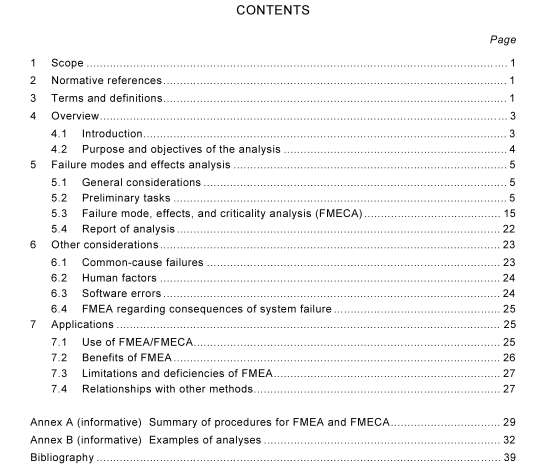AS IEC 60812 pdf – Analysis techniques for system reliability—Procedure for failure mode and effects analysis (FMEA)

AS IEC 60812 pdf – Analysis techniques for system reliability—Procedure for failure mode and effects analysis (FMEA)
4 Overview
4.1 Introduction Failure Modes and Effect Analysis (FMEA) is a systematic procedure for the analysis of a system to identify the potential failure modes, their causes and effects on system performance (performance of the immediate assembly and the entire system or a process). Here, the term system is used as a representation of hardware, software (with their interaction) or a process. The analysis is successfully performed preferably early in the development cycle so that removal or mitigation of the failure mode is most cost effective. This analysis can be initiated as soon as the system is defined enough to be presented as a functional block diagram where performance of its elements can be defined. FMEA timing is essential; if done early enough in the development cycle, then incorporating the design changes to overcome deficiencies identified by the FMEA may be cost effective.
It is therefore important that the FMEA task and its deliverables be incorporated into the development plan and schedule. Thus, FMEA is an iterative process that takes place coincidentally with design process. FMEA is applicable at various levels of system decomposition from the highest level of block diagram down to the functions of discrete components or software commands. The FMEA is also an iterative process that is updated as the design develops. Design changes will require that relevant parts of the FMEA be reviewed and updated. A thorough FMEA is a result of a team composed of individuals qualified to recognize and assess the magnitude and consequences of various types of potential inadequacies in the product design that might lead to failures. Advantage of the team work is that it stimulates thought process, and ensures necessary expertise. FMEA is considered to be a method to identify the severity of potential failure modes and to provide an input to mitigating measures to reduce risk. In some applications however, FMEA also includes an estimation of the probability of occurrence of the failure modes. This enhances the analysis by providing a measure of the failure mode’s likelihood. Application of FMEA is preceded by a hierarchical decomposition of the system (hardware with software, or a process) into its more basic elements. It is useful to employ simple block diagrams to illustrate this decomposition (IEC 61 078). The analysis then starts with lowest level elements.
A failure mode effect at a lower level may then become a failure cause of a failure mode of an item in the next higher level. The analysis proceeds in a bottom-up fashion until the end effect on the system is identified. Figure 1 illustrates this relationship. FMECA (Failure Modes, Effects and Criticality Analysis) is an extension to the FMEA to include a means of ranking the severity of the failure modes to allow prioritization of countermeasures. This is done by combining the severity measure and frequency of occur- rence to produce a metric called criticality. The principles of an FMEA may be applied outside of engineering design. FMEA procedure can be applied to a manufacturing or any other work process such as in hospitals, medical laboratories, school systems, or others. When FMEA is applied to a manufacturing process, this procedure is known in industry as the Process FMEA, or PFMEA. For an FMEA to be effective, adequate resources for a team work have to be committed. A thorough understanding of the system under analysis may not be essential for a preliminary FMEA. With development of design, a detailed failure mode analysis requires thorough knowledge of the design performance and its specifications. Complex engineering designs usually require the involvement of multiple areas of design expertise (e.g. mechanical engineering, electrical engineering, systems engineering, software engineering, maintenance support, etc).









